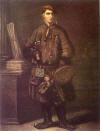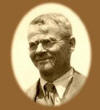
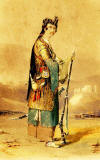
In 1839 Sir Austen Henry Layard set off on what was to become the most remarkable equestrian journey of the 19th century. Layard departed from England with Edward Mitford. Their destination was Ceylon, which was 7,000 miles away. The two young men survived a remarkable series of adventures. They were held hostage by a giant robber chieftain in Montenegro. After obtaining a royal firman from the Sultan of the Ottoman Empire, Layard and Mitford explored the Middle East, were they drew and documented the remains of Roman and Greek civilisations. Their next destination was the ancient country of Assyria, today’s modern Iraq. Both men were keen amateur archaeologists who investigated ruins they found in the countryside. They then rode into Persia, with the intention of continuing across Afghanistan and through the Khyber Pass into British Raj India. When the Persian Shah refused to grant them permission to take the route they chose, Layard decided to return to Assyria to carry out more excavations. Upon his return, Layard discovered the ancient city of Nimrud on the shores of the Tigris River. An avid equestrian explorer, Layard later travelled with the nomadic Bakhtiari nomads.

There are
very few unsolved mysteries amidst the Long Rider world. The fate of
Ludwig Leichhardt, the German equestrian explorer who disappeared in
Australia in 1848 heads the list.
A meticulous scientist, Leichhardt had studied the natural sciences and languages at the universities of Gottingen and Berlin. After immigrating to Australia, he took an intense interest in his adopted homeland, keeping careful notes on the unexplored continent’s terrain, wildlife and its native inhabitants, the Aborigines.
One his first journey into the interior, Leichhardt spent 18 months travelling more than 3000 miles along the continent’s eastern coast to the top of Australia. Having long been given up for dead, when Leichhardt returned to Sydney in 1846, he was hailed as the “Prince of Explorers.”
This remarkable journey earned Leichhardt gold medals from the geographical societies in Paris and London. But the modest traveller did not allow his new found fame to go to his head. As he began preparations for his next trip, Leichhardt wrote, “I’ve had the pleasure of hearing that the geographical society in London has awarded me one of its medals, and that the Parisian geographical society has conferred a similar honour upon me. Naturally I’m very pleased to think that such discerning authorities consider me worthy of such honour; but whatever I have done has never been for honour. I have worked for the sake of science, and for nothing else.”
The scientist turned Long Rider didn’t have any time to think about the polished parlors of Paris. He had become obsessed with crossing the unexplored centre of Australia from east to west.
Leichhardt set off in March 1848 in the company of seven men and horses, twenty mules and fifty bullocks. The expedition carried enough supplies, food and weapons to last them for several years.
They were never seen again.
Even the vast amounts of metal normally associated with a 19th century expedition of this nature, such as horse shoes, iron stirrups, brass harness, knives, telescopes and coins, have never been found. The only relic which may be linked to Leichhardt was the burned remains of a gun which was found lodged within the bole of tree that had the initial “L” carved in the bark.
Various theories have circulated for years about what happened to Leichhardt. Some believed he and his men starved in the Outback. Others have suggested that the German scientist took up residence with an Aboriginal tribe and chose never to return to civilisation, an idea which was later resurrected and used to explain the 20th century disappearance of Amazon explorer Sir Percy Fawcett.
Regardless of exactly where, when and how Leichhardt died, his last days have remained a mystery for nearly two-hundred years – until the recent discovery of a mysterious equine portrait.
Then in 2009 it was revealed that an Aboriginal rock painting located in the rugged stone country in Arnhem Land might depict the vanished Long Rider. The stylized drawing shows a European figure man wearing a broad-brimmed hat. He is mounted on a mare that is urinating. The mare is seen to be wearing chest and knee guards, a practice Leichhardt used to protect his horses against the dangerous thorns found in the Outback.
Is it the long-lost Long Rider? No one yet knows as Leichhardt’s disappearance remains unresolved.
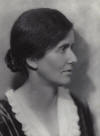
Margaret Mary Leigh – was first person known to have undertaken an equestrian journey after having been inspired by Swiss Long Rider Aimé Tschiffely. Leigh rode from Cornwall, England, to Strathascaig, Scotland, in 1938. Soon afterwards she wrote a delightful book about her ride entitled My Kingdom for a Horse. In that book she acknowledges Tschiffely’s influence. Additionally, in a special chapter entitled “Preparations,” she published one of the first attempts to provide valuable information designed to educate others on how to successfully undertake an equestrian journey.
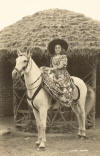
Few Englishmen, and still fewer women, had ridden from the Pacific port of Ampala, over the mountains of Honduras, to the Atlantic in the late nineteenth century. Yet that is what the refined Mary Lester set out to do. The intrepid traveller was labouring under a handicap as reliable maps were rare and what verbal advice was on offer turned out to be dubious and out of date. Yet such inconveniences did nothing to dampen the adventurous spirit of the lady who preferred to ride under the pseudonym “Maria Soltera.” Regardless of what they called her, the people in Honduras soon leaned to respect the courage and determination of the foreign Long Rider. “I do not fear hardship,” she told them, “as I am the daughter of an English soldier and circumstances have compelled me to depend on myself.” Lester wasn’t making an idle boast. In excellent Spanish, she haggled over saddles, hired mules, deflated bullies and outwitted nefarious guides. She was, in a word, a fire-cracker whose combustible ride across the verdant mountains is still a tale to remember. Thus A Lady’s Ride Across Spanish Honduras is a gem of a book, with its entertaining account of Mary’s vivid, day to day life in the saddle. Yet the hardy amateur author was a keen observer who noted the exotic animal life, social customs, and political conditions of a jungle-trail-world that belonged to that simpler age. Complete with drawings from her journey, Lester’s colourful writing brings the “lost” civilization of Spanish Honduras back to life more than a century later.
(This image does not actually portray the Historical Long Rider. It was chosen so as to demonstrate the clothes and type of horse used during this important journey. The Guild continues to search for a photo depicting the Long Rider and will publish it when found.)
At
first glance he didn’t look like a biological pioneer or an extraordinary Long
Rider but that’s what Carl Linnaeus was. Of course part of the reason no
one recognized his importance back in 1732 was because young Carl was still
thought of as being merely the eldest son of a small-town curate in Sweden.
All that changed on the day before his twenty-fifth birthday. That’s when he
saddled his horse, and armed with a plant press and a crazy notion, Linnaeus
rode away from his family’s home in Uppsala, Sweden and into scientific history.
His mission was to journey north into “Lapland,” an area inhabited by the ethnic
Sami tribes people who lived on the frozen tundra with their reindeer.
Linnaeus was convinced that this glacier-carved Arctic region had plants which
were of scientific importance. Yet when he began to discover, and wished to
classify these rare and useful plants, Linnaeus realized that the current system
of studying and naming plants and animals was a linguistic shambles, with
various complex names being given to the same species based on a wide body of
multiple criteria. Linnaeus the Long Rider changed all that. During his
equestrian journey Linnaeus devised a system of classifying living things based
on a single specific epithet unique to that item. For example,
the human species
is uniquely identified by the binomial Homo sapiens. No other species of
animal can have this binomial. Prior to the system now known as Linnaean
taxonomy, animals were classified according to their mode of movement.
During his productive
and pleasant stay with the Sami, Linnaeus adopted the local clothes and
lifestyle of his resourceful hosts. Though he was learning to relish meals of
reindeer meat, the fledgling scientist was also busy discovering more than 100
new plant species. In fact Linnaeus is credited with having classified and named
more than 4,000 animals and nearly 8,000 plants during his career. Thus it is
often said that Lapland was for Linnaeus what the Galapagos Islands were for
Charles Darwin, the other famous Long Rider scientist who was to follow. Yet
while the scientific discoveries of both men are now well-known, few recall that
they shared a common love of equestrian travel.
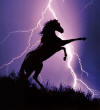
History
is filled with the names of men and women who are famous for having
undertaken great deeds. The great Protestant Reformer Martin Luther
is such an example.
On October 31, 1517, after undergoing a considerable time fasting and praying, Luther nailed his now famous “95 Theses” to the door of the castle church in Wittenberg, Germany. This act of conscience sparked a religious revolution that split Europe into opposing political camps and redefined Christianity. Luther went on to translate the Bible into German, which in turn paved the way for the creation of the popular King James edition of the holy book.
Yet Luther’s road to religious reform started in the saddle during the summer of 1505.
A brilliant student, he had received his master’s degree at the age of twenty-two.
Even at this early age Luther was questioning the meaning of life. Thus he had spiritual reservations when his father urged him to seek a degree in law instead of in theology or philosophy. But having bowed to parental pressure, Luther mounted his horse and reluctantly set off to attend law school. That equestrian journey had unexpected results.
A bolt of lightning split the sky. The scholar’s frightened horse threw Luther to the ground and fled. Fearing for his life, Luther called out, “Help! Saint Anna, I will become a monk.”
The former mounted law student then walked home and announced his intention to pursue a life of religious studies.
Perhaps this early equestrian episode explains why Europe’s most famous Protestant reformer later referred to horses in several of his works. One of Luther’s more famous quotes states, "History is like a drunken man on a horse. No sooner does he fall off on the left side than he mounts again and falls off on the right."
